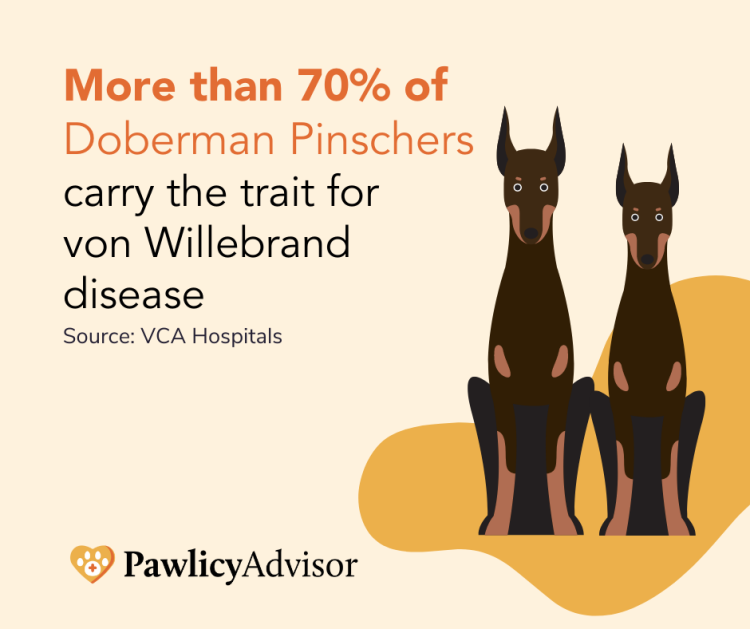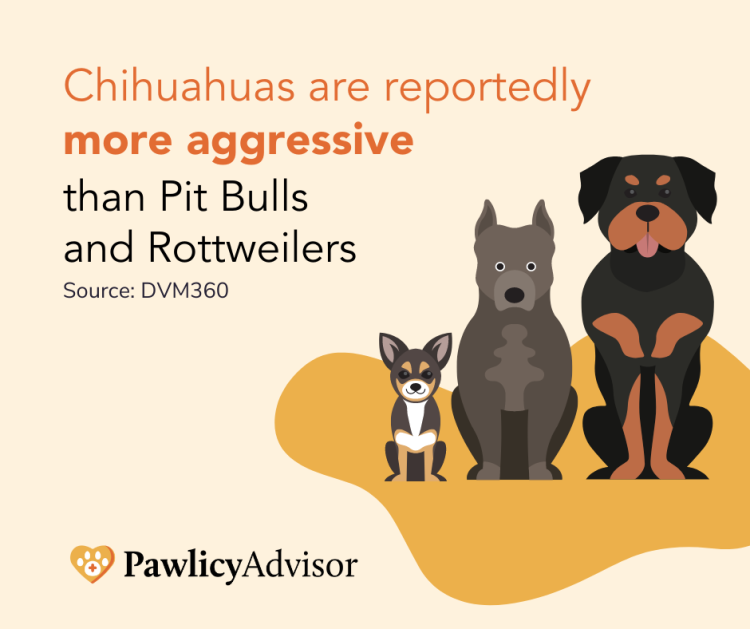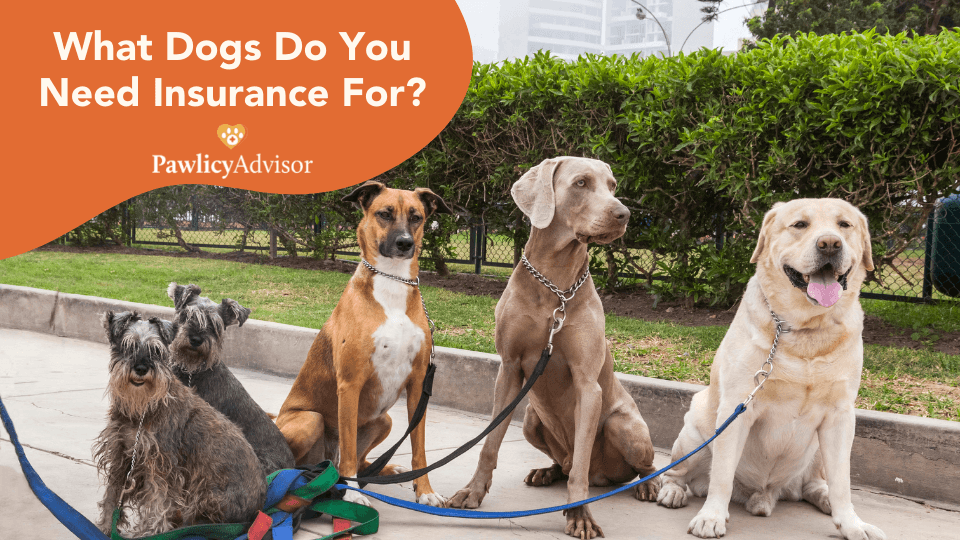If you think your pet would never hurt a fly, you might wonder, “Does my dog really need insurance?” It might seem tempting to avoid a monthly insurance premium, but consider this: statistics show that dogs bite 4.5 million people in the United States every year; of those, one in five people will require medical attention.1
If your dog happens to bite someone — or, accidentally hurts someone just by knocking them down while over-excited — and the person takes you to court, you will most likely be held liable for their medical bills.
Which Types Of Dog Insurance Do I Need?
In that scenario, you’ll need dog insurance to help cover the damages, otherwise, you might be forced to pay tens of thousands of dollars out-of-pocket. In fact, State Farm recently reported that it paid out over $132 million per result of about 3,610 dog-related injury claims, the average of which cost $36,573 per incident.2
While that figure could cause financial ruin for any family, it doesn’t even consider the hundreds of dollars spent annually on caretaking for a healthy dog — let alone one that incurs expensive vet bills due to a severe injury or sudden illness.
The truth is, our canine companions can be expensive, but insurance can help. Some dogs need insurance coverage more than others, so today’s post will go over the top 10 dog breeds to get insurance for, in case you haven’t already.
Use the links below to learn which 10 dogs may need insurance the most and why:
- Why do some dogs need insurance coverage?
- What dog breeds need insurance the most?
- Factors that increase the need to insure your dog
- Is insurance coverage worth getting for dogs?
- How to save money on dog insurance
- Key Takeaways
Why do some dogs need insurance coverage?
Considering that less than 20% of people can afford to pay for their pet’s $5,000 vet bill out of pocket, most outdoor dogs and indoor dogs need pet insurance equally. Health insurance may be more valuable for puppies, while senior pets with several pre-existing conditions stand to benefit the least. However, pet liability insurance is another important form of financial protection to consider.
Many people receive liability coverage through their homeowners or renters pet insurance policy. However, to reduce their financial risk, most insurance companies implement coverage restrictions for certain “aggressive” breeds (though activists in some states have fought to outlaw this form of prejudice). This means that if your canine companion is on the list of dogs excluded from insurance and causes either physical or property damage, your policy won’t protect you financially.
You might also live in a state where local breed-specific legislation (BSL) requires liability coverage for certain dogs up to a specific amount, which may exceed the limit in your insurance policy. Additionally, tenants with pets might find that their property’s insurance policy excludes third-party liability. In either case, these dogs need insurance from a separate provider to fill the gap in coverage.
PRO TIP: Whenever you’re looking for any type of pet insurance policy, always pay attention to the unique needs of your dog’s breed in the fine print to avoid any unpleasant surprises later on.
What dogs need insurance the most?
Exactly which dog breeds are considered aggressive and banned from insurance coverage varies by provider and state (you can check out the breed restrictions by state here). Here’s a summarized list of dogs often banned from insurance policies:
Akita
The Akita is ranked eleventh on the list of dogs with the strongest bite in terms of pound per square inch (PSI).3 With a force of 350 to 400 PSI, an Akita’s bite could cause severe damage and result in very expensive medical bills. Additionally, Akitas had one of the lowest overall passing rates in the temperament test conducted by the American Temperament Test Society (ATTS)4, which measures how well-mannered a dog behaves in various settings. This combination of traits means that these dogs could present a substantial financial risk and may need liability coverage more than other breeds.
Keeping Akita dogs healthy might also require great medical care, as these Japanese dogs are more prone to certain health issues including sebaceous adenitis and hip dysplasia. For this reason, many owners choose to buy Akita pet insurance as a way to ensure affordable coverage for their pets.
Alaskan Malamute
Although Alaskan Malamutes had a passing rate of 84.4% on the ATT test4, the breed is still banned by 26% of home insurance companies.5 Check your policy to confirm whether your dog needs insurance coverage from a separate provider.
Taking out pet insurance for Alaskan Malamutes might be a good idea, too, because the breed is prone to bloat — otherwise known as gastric dilatation-volvulus, a serious condition that leads to fatality in 30% of affected dogs, even with veterinary treatment. Surgery to treat bloat can cost between $2,500 to $5,000 for a case without complications.
American Staffordshire Terrier
For insurance purposes, the American Staffordshire Terrier (known as the AmStaff or Staffie) is generally classified as a “pit bull”, along with Staffordshire Bull Terriers, Bull Terriers, American Bull Terriers, and any combination of these breeds. Even though the ATTS found the AmStaff temperament to be among the most tolerant of all dog breeds — even scoring higher than the well-loved Golden Retriever4 — pit bulls consistently land at the tops of aggressive dog lists due to their tragic lineage in dogfighting.
You might not use the liability coverage in your pit bull insurance policy, but you could likely benefit from American Staffordshire Terrier pet insurance. The breed is prone to various health issues in dogs, including elbow dysplasia, hypothyroidism, progressive retinal atrophy, and cerebellar ataxia.
Bulldogs
Similar to pit bulls, “bulldogs” is an umbrella term for several breeds historically known to fight bulls for sport — but today, they are recognized as the dogs that bite the most.6 American Bulldogs and English Bulldogs are also responsible for the worst dog bites, so you might need insurance for these dogs more than others.6
Also, bulldogs belong to the brachycephalic class, a type of canine anatomy that results in a short head and snout. This physical characteristic often leads to a number of health problems in bulldogs, usually relating to the nose, eyes, teeth, and respiratory system. The cost to diagnose and treat common health issues in bulldogs can reach up to $7,500, but a pet insurance policy could reimburse you for up to 100% of those costs, so long as your deductible is met and the issue is not considered a pre-existing condition.
Cane Corso
The Cane Corso has the third strongest bite at 700 PSI3 and is blacklisted by 19% of insurance companies,5 although many of these intimidating beasts are truly gentle giants.
They are also prone to breed-specific health issues, such as epilepsy, gastric dilatation-volvulus, and eyelid abnormalities. These health risks typically manifest as the dog progresses in age, which is why it’s important to sign up for Cane Corso pet insurance as early as possible.
Chow Chow
Nearly 30% of Chows Chows failed the ATTS test,4 which means they may be more likely to bite and may need more insurance protection than others. They are also one of the most banned dog breeds, excluded from 95% of insurance policies.5
Chow Chows are at an increased risk of developing hypothyroidism, which can increase their risk of skin and ear infections, obesity, and depression. The cost to treat hypothyroidism in dogs can cost about $850 only in the first year. Depending on the plan, pet insurance can help reimburse you for up to 100% of these costs.
Doberman Pinscher
The giant Doberman Pinscher is another breed that has a reputation for being aggressive, though certainly not always deserved. More than 20% of Dobermans failed the official temperament test,4 and they’re included in all banned breed lists.5
Pet insurance for Doberman Pinschers could prove especially valuable, as 70% of these dogs are affected by von Willebrand disease. Dobies are also known to be more susceptible to certain types of cancer, dilated cardiomyopathy (DCM), liver inflammation, wobbler syndrome, and bloat.

German Shepherd
German Shepherds are extremely intelligent and make excellent working dogs. In fact, the breed is responsible for 6.8% of dog bites involving children, several of which have resulted in a fatality,** and ranks fourth on the list of dogs known to bite most often.6**
Many large-breed dogs need pet insurance, including German Shepherds, because healthcare is often more expensive due to their need for stronger doses (of medication, anesthetic, etc.) and their veterinary procedures may require more time. As a breed, they are prone to issues in the hips and gastrointestinal (GI) tract, so you might consider German Shepherd insurance as a way to reduce the cost of vet bills.
Labrador Retriever
Much to many people’s surprise, Labrador Retrievers are responsible for over twice as many bites involving children (15.6%) than pit bulls (7.5%)6, which were more likely to occur when running at large or during possessive aggression. Labs may be loving family dogs, but if they were to snap at a kid over their favorite toy, you might be glad they had insurance coverage.
When it comes to health issues, Labs are highly susceptible to elbow and hip dysplasia, as well as knee-related issues and eye problems. Labrador Retriever insurance is designed to protect your dog against these risks by providing access to the best veterinary care possible, while also protecting your bank account from the burden that can come with unexpected veterinary bills.
Rottweiler
Although the Rottweiler bite only has the force of 328 PSI3 and passed the ATTS at a rate of 84.7%4, the breed is on all banned lists5 nonetheless. If you own a home, you may likely need an additional insurance policy for these pet dogs, as your homeowners policy may exclude or severely restrict third-party liability coverage for dog-related claims.
Rotties can be wonderful dogs and are deserving of the best care, but the breed is commonly affected by heart disease, such as aortic stenosis, which is very expensive to treat. Whether you keep one as a pet or a working dog, Rottweiler insurance can be a smart investment that helps you cover expenses related to illnesses, accidents, and emergencies.
Additional Mentions
Note that this list is not exhaustive. Each insurance provider has its own unique list of banned dog breeds, many of which include:
- Dachshund
- Golden Retriever
- Great Dane
- Jack Russel Terrier
- Mastiff
- Presa Canario
- Saint Bernard
- Siberian Husky
- Wolf hybrids
It’s also important to keep in mind that not all “aggressive” dogs come from breeds that are large in size. For example, the Chihuahua is responsible for nearly 5% of dog bites involving children, which is more than Rottweilers (3.9%).6 One study even identified Chihuahuas as the most aggressive breed of dog, well above pit bull types.7 Although their bite may be weaker in strength, an ill-tempered Chihuahua could still cost you a lot of money, regardless of how damaging the injury might be.

PRO TIP: Ultimately, any dog can bite anyone at any given time, no matter how well-trained they are. Similarly, all dogs can experience health issues ranging from mild to severe despite how carefully you treat them. Dog insurance provides valuable peace of mind for these “just in case” scenarios.
Factors that increase the need to insure your dog
While these dogs need insurance the most, there are several additional factors that increase the need to insure your four-legged friend: age, environment, and behavioral history.
Age
Puppies need insurance the most, even though they might be in good health at the moment. Signing up your dog for insurance while they are still young will give you the most opportunities to use your plan for all the various health issues in dogs that can pop up and ensure there are no coverage exclusions later in life.
Untrained puppies are also likelier to damage the property of others, such as peeing on a friend’s laptop or chewing up a neighbor’s couch, which could be covered by insurance. They might also injure someone on accident, especially if they’re a puppy of a large breed.
Environment
Outdoor dogs present a higher risk of attacking another dog or person, so they might need liability insurance more than indoor dogs. Also, some states (such as California, Florida, Texas, and New York) have much higher incident rates of insurance claims for dog bites than others.8 If you live in one of these areas, insuring your dog may prove valuable given the higher chance of an expensive lawsuit.
Behavioral issues
Even if your pet wasn’t mentioned on the list of breeds excluded from most insurance policies, any aggressive dog presents a financial risk. The AVMA offers suggestions on how to prevent dog bites, but many dog health insurance plans cover the cost of training to correct behavioral issues.
Is insurance coverage worth getting for dogs?
The cost of pet insurance for a dog is cheap compared to the tens of thousands of dollars in medical bills you might be held responsible for. The data shows no signs of insurance claims for dog bites slowing down, but rather the opposite. In 2020, the number of nationwide claims increased to 16,991, and the average cost per claim grew 12.3% from $44,760 to $50,425.9 Without insurance coverage, you could be responsible for paying that amount with your personal finances.
Similarly, health insurance premiums are much more affordable than the total cost of an emergency vet visit that can easily add up to $5,000 or more, or the money you might have to spend every month on prescription medication and ongoing tests to manage your dog’s unexpected, ongoing condition.
For these reasons, most owners agree that pet insurance for dogs is well worth the cost.
How to save money on dog insurance
Look for dog-friendly insurance providers that don’t have coverage restrictions on breeds in order to avoid paying for a separate liability policy. Also, some insurance companies allow owners to bundle home insurance and pet insurance and save money. The list includes:
- State Farm
- Liberty Mutual
- Allstate
- Geico
- Farmers
- USAA
Combining policies is a great way to ensure complete coverage for your dog’s health and your financial security. By using Pawlicy Advisor’s pet insurance comparison tool, you can learn what plans are recommended for your dog’s specific breed, see what’s covered by each policy, find hidden discounts, and enroll within minutes. Start your search to get started today.
Key Takeaways
- There are two main types of insurance products for dogs: health coverage and liability coverage.
- Some dog breeds are considered aggressive and banned by insurance companies. The list includes Akita, Cane Corso, Pit Bull, Rottweiler, Doberman, etc.
- The most important factors that increase the need to insure your dog are environment, age, and behavioral history.
- If you don’t have insurance and your dog injures someone, you’ll be responsible for covering the expenses out of pocket. Some insurance companies allow owners to bundle pet insurance and home insurance for money.
References
- CDC “Dog Bite Prevention Week”
- USPS “National Releases”
- Pet Comments “Top 23 Dogs with the Strongest Bite”
- ATTS “ATTS Breed Statistics”
- Forbes Advisor “Dog Breeds Banned By Home Insurance Companies”
- DVM360 “Study: Chihuahuas bite vets most; Lhaso Apsos inflict worst injuries”
- The Atlantic “Pit Bulls are Chiller than Chihuahuas”
- Tableau Public “Dog Bites By State”
- III “Spotlight On Dog Bite Liability”
